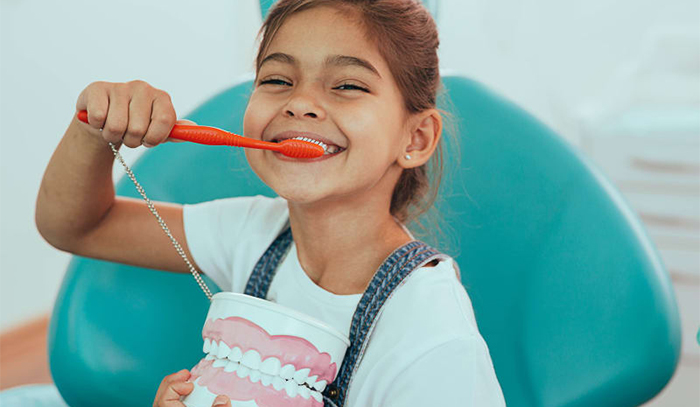Teaching children to care for their teeth can sometimes feel like a daily battle, but it’s one of the most important lessons you can instil in them. A lifetime of healthy teeth and gums begins with the habits they form as kids. In this guide, we’ll explore why dental care is essential for children, how to make it fun, and tips for ensuring those healthy habits stick. Let’s make those pearly whites shine!
Why Good Dental Habits Are Crucial for Children
When it comes to children’s health, oral hygiene is often overlooked until a problem arises. However, good dental habits are about more than just keeping teeth clean—they are integral to a child’s overall well-being.
The Connection Between Dental and Physical Health
The health of your child’s teeth and gums affects more than just their smile. Poor oral hygiene can lead to painful cavities, gum disease, and infections that may interfere with eating, speaking, and even sleeping. Beyond these immediate concerns, there’s also growing evidence linking oral health to broader physical health issues. Infections in the mouth can affect the heart, lungs, and even the immune system. Starting kids on the right path early can help them avoid such complications.
The Impact of Poor Oral Hygiene
Childhood cavities remain one of the most common chronic diseases in kids. Untreated dental problems can affect concentration, self-esteem, and overall quality of life. Moreover, these issues can set the stage for lifelong dental challenges. By teaching children proper dental care from an early age, you’re investing in their future comfort, confidence, and health.
How to Make Dental Care Fun and Engaging
Getting kids excited about brushing and flossing can be tricky, but with the right tools and attitude, you can transform it into an activity they look forward to.
Choosing the Right Tools
Selecting the right toothbrush makes a big difference. Look for brushes with soft bristles and small heads designed for little mouths. Better yet, pick one with bright colours or featuring their favourite character—it adds an element of fun. Electric toothbrushes with built-in lights or music are another great option. Similarly, flavoured toothpastes specifically made for children can make brushing less of a chore. Ensure the toothpaste contains fluoride to strengthen enamel and protect against decay.
Making It a Game
Turn brushing into a challenge by using timers shaped like animals or apps that reward kids for completing their brushing sessions. You can even make up a story about their toothbrush being a “hero” battling sugar bugs to save their teeth! This imaginative approach can make even the most reluctant brusher eager to participate.
Lead by Example
Children often emulate what they see. If you make brushing and flossing a visible part of your routine, your child is more likely to follow suit. Better yet, turn it into family time where everyone brushes together—kids are far more likely to enjoy the process when it feels like a group activity.
Step-by-Step Guide to Teaching Kids Proper Dental Care
Learning to care for their teeth can seem overwhelming to children, but breaking it into manageable steps helps make the process approachable and effective.
Brushing Techniques for Children
One tip for brushing is to show your child how to hold their toothbrush at a slight angle and use gentle, circular motions to clean all surfaces of their teeth and clean the spaces between the teeth and gums. Emphasise the importance of brushing for two full minutes, reaching the front, back, and chewing surfaces. Encourage them to spit out the toothpaste but avoid rinsing to allow fluoride to have time to soak and keep protecting their teeth.
The Importance of Flossing and How to Introduce It Early
Flossing can be introduced as soon as two teeth touch. Start by using colourful, child-friendly floss picks to make the process simpler. Demonstrate how to gently glide the floss between teeth without snapping it. At first, you may need to assist younger children, but over time, they’ll get the hang of it. Teaching this habit early sets the stage for strong gum health as they grow.
The Role of a Balanced Diet in Oral Health
What your child eats is just as important as how they brush. Encourage foods like cheese, leafy greens, nuts, and crunchy fruits and vegetables that help strengthen teeth and stimulate saliva production. Limit sugary treats and drinks, which can lead to decay. If they do indulge, make sure they brush soon after to protect their teeth.
Encouraging Consistency with Daily Habits
Consistency is the cornerstone of long-term success in maintaining healthy teeth and gums. Here’s how to make it stick:
Creating a Dental Care Routine
Create a daily schedule that includes brushing in the morning and before bed. Visual aids like a colourful dental routine chart or checklist can help kids keep track of their progress. Celebrate small milestones, such as a week of consistent brushing, to keep them motivated.
Reward Systems to Motivate Children
Kids respond well to rewards. Consider a sticker chart where they earn a small prize after a week of brushing without reminders. Be creative—rewards can include anything from a special outing to extra storytime before bed.
Using Songs or Timers to Make Brushing Fun
Sing a song or play a two-minute music to ensure they brush long enough. Some toothbrushes even have built-in lights or apps that turn brushing into an interactive experience.
Common Mistakes Parents Make and How to Avoid Them
Even the most well-intentioned parents can make mistakes when it comes to their child’s oral health. Here are some pitfalls to watch for:
Neglecting Baby Teeth Because They’ll Fall Out
While baby teeth are temporary, they play a critical role in chewing, speech development, and guiding permanent teeth into place. Neglecting them can lead to painful infections and long-term dental issues. Make sure to care for baby teeth with the same attention and diligence as adult teeth.
Overlooking the Importance of Regular Dental Check-ups
Regular dental visits are essential for early detection of potential issues. Many parents wait until there’s a visible problem, but bi-annual check-ups allow dentists to spot concerns before they become serious. Regular check-ups also help kids be more familiar with and have a friendlier perspective of dental care and visits to the dentist.
Allowing Sugary Snacks Before Bedtime
Sugary snacks or drinks before bed are particularly harmful, as saliva production decreases during sleep, leaving sugar to wreak havoc on teeth. Always ensure your child brushes after their last snack or drink of the day.
When to Visit the Dentist and What to Expect
The first dental visit should happen by your child’s first birthday or six months after their first tooth appears. These visits are designed to be gentle and informative. The dentist will check for early signs of decay, assess how teeth are developing, and offer advice on oral care techniques tailored to your child’s age. After which, it’s recommended to see the dentist bi-annually or if there is dental discomfort, signs of tooth decay, or tooth damage.
Additional Tips for Parents
- Start Early: Introduce oral care routines as soon as the first tooth appears.
- Stay Positive: Frame dental visits and brushing as exciting milestones rather than chores.
- Educate Your Child: Explain the importance of caring for their teeth using simple, relatable terms.
- Be an Example: Show your kid that you put in effort to keep your teeth strong, paying as much attention to your teeth as you with their teeth.
By starting early, making it fun, and staying consistent, you can give your child the tools they need to maintain a healthy, happy smile. After all, every small step you take today contributes to a lifetime of strong, healthy teeth!
FAQs
At what age should brushing start?
Begin cleaning your baby’s gums even before teeth appear. Once the first tooth erupts, switch to a soft-bristled toothbrush.
How often should kids brush and floss their teeth?
Kids should brush twice a day and floss once daily to keep their teeth and gums healthy.
What are the best ways to avoid cavities in children?
Limit sugar, encourage regular brushing, and visit the dentist twice a year.
Are fluoride toothpaste safe for young children?
Yes, fluoride toothpaste is safe in small amounts. Supervise younger kids to ensure they don’t swallow it.
How can I ease my child’s fear of the dentist?
Choose a family-friendly dentist who creates a welcoming environment. Read books or watch videos about dental visits to familiarise them with the process.


